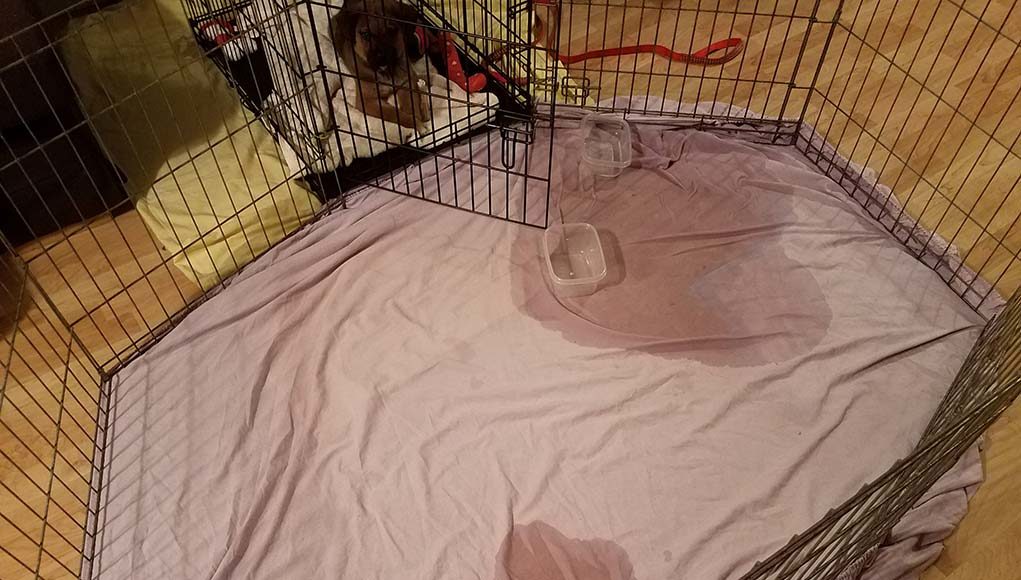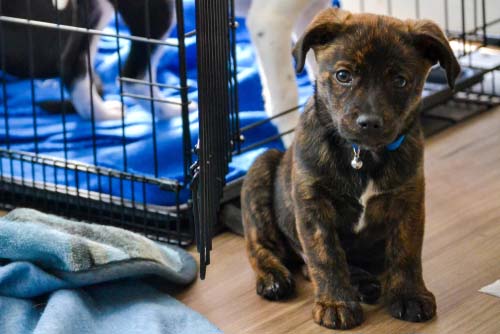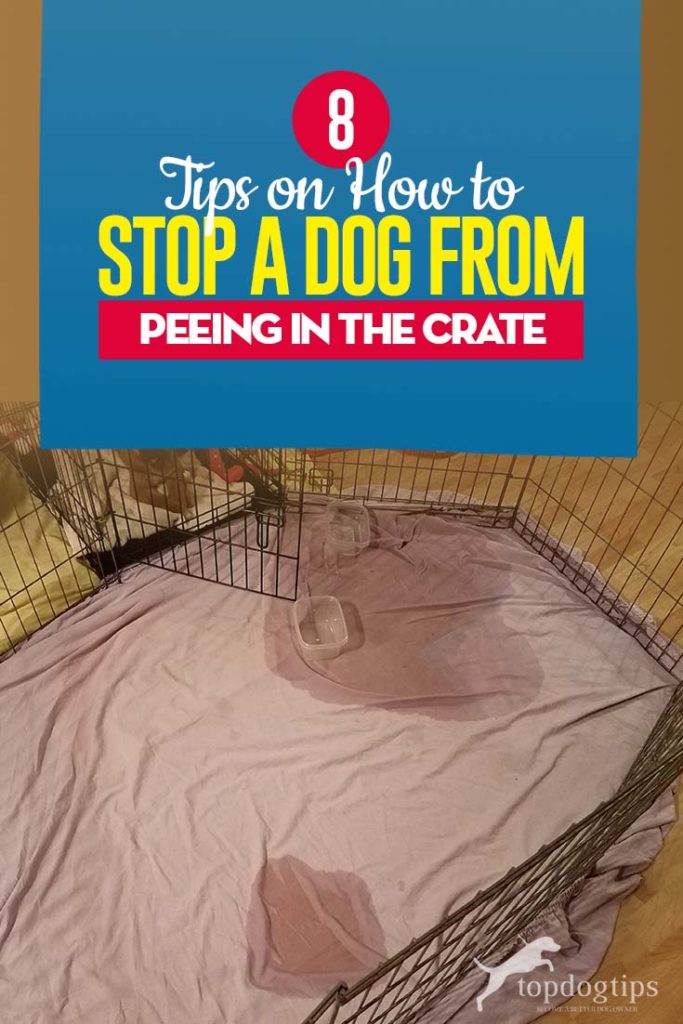There's more than one reason why your dog is peeing in the crate, and determining the cause of this is crucial in order to fix the problem. This could be either a medical issue, or a behavioral one. Some of the most common non-medical causes are:
- You've moved into a new house (new environment)
- Your schedule, and thereby your dog's schedule, have changed
- Any major changes in your/your dog's home (causing anxiety)
For example, if you've changed jobs and are now putting your dog in a crate and letting them out during different times, this could cause them to soil the crate. Routine and strict schedule is extremely important for dogs to keep the stress away; every time there's a change, it causes anxiety, which may cause them to accidentally eliminate themselves.
If your dog has already been house-trained and crate-trained but is now peeing in a crate, then follow these steps to learn how to stop him from doing so.
Step #1: Rule Out Any Illnesses
The most important step is to rule out any medical issues that could be causing your dog to pee in the crate. The most common condition to cause this is UTI (urinary tract infection). Before going to the veterinarian, note the following;
- How often your dog is urinating in the crate?
- Any unusual odor or discoloration (bloody or dark)?
- Any recent changes to your dog's diet?
- Any changes or additions of new medications or supplements?
Senior dogs may start peeing in the crate as they are more prone to medical conditions that can cause incontinence or other urine-related illnesses.
Step #2: Have a Strict Schedule
Once medical issues have been ruled out, and assuming you've gone through housebreaking and crate training with your dog, the next steps to prevent a dog from peeing in the crate are through supervision and a strict schedule which you keep.
The routine rule applies for your house/crate training phases, as well as for anything that comes after that. Have a crate training schedule that your dog is familiar with, and then set strict times for feeding, sleeping, going outside and other. After your pet adjusts to these times, they are less likely to pee before the time comes. However, if you break the schedule, this may cause anxiety for the dog, and they are likely to pee indoors.
Feeding schedule in particular can also be used to take control over when your pup is to eliminate themselves. Dogs that eat and then drink some will usually need to eliminate themselves within 15 to 30 minutes. So unless you're free-feeding your pet, take advantage of this predictable behavior.
Step #3: Is the Crate too Big?
It's important to pick the right dog crate size. Measure your pet and choose a crate that's large enough for the dog to stand up and turn around, and not any bigger.
When the kennel is too big, there's a good chance your dog is using one end to eliminate in while lounging in the other end. This is a self-rewarding behavior for a dog and they likely do not perceive that part of the crate as a “no pee” zone.
However, there are exceptions to the crate-sizing-rule.
- Puppy Mill Dogs. Dogs purchased from a puppy mill, irresponsible and illegal breeders or a pet store that works with puppy mills may become accustomed to peeing and sleeping in their waste because they're not being taken care of properly.
- Habit. If previously you've purchased a dog crate that was too large, your pooch may have developed a habit of peeing inside of it, and will require retraining.
- Small Dogs and Puppies. It's more common for small dogs and especially puppies to eliminate in their crates because they have tiny bladders and can't hold it as long, meaning the size isn't the issue but the time the dog spends in a crate is.
Step #4: Let the Dog Out More Frequently
Speaking of time spent in a crate, this applies to all dogs, too. The general rule of bladder control for a healthy, average-sized puppy is one hour per month of age. Therefore, a six-month-old puppy can hold their bladder for only six hours.
However, this rule may not apply to small breeds or those that have a medical issue causing them to urinate more. Puppies also do not know they are supposed to hold their pee until you've completed housebreaking training with them.
Step #5: Modify Your Expectations
Know your dog and modify your expectations accordingly. For example, a five-pound Chihuahua cannot be expected to hold their pee for as long as an adult Rottweiler.
Keep note of the bladder-control rule discussed earlier when gauging times. In general, eight hours is the maximum any dog should be expected to hold their bladder and bowels. Don't set your dog up for failure by pushing the dog past their limits.
Step #6: Reinforce Good Behavior
Whether you have a puppy or an adult dog, using pet treats, verbal commands with praise and petting to reward them when the dog pees outside is an excellent way to reinforce such good behavior.
To do this, you will have to take your pup out of the crate, bring them outside and watch for them to eliminate. After the dog pees, praise them and give them a treat. The pee-payment method works well, especially if you reserve an exclusive dog treat just for this training (something you don't feed the dog any other time).
Step #7: Discover Why with Technology
If you have eliminated any underlying illnesses for a dog's peeing in the crate, another issue this could be is separation anxiety. An excellent way to see what your dog is doing after you leave home is to set up a dog camera (cell phones work well, too).
If your dog is peeing in a crate as a result of suffering from separation anxiety, you are likely to witness the following:
- Crying and/or barking for longer than a few minutes
- Digging or biting at the crate
- Excessively licking themselves
- Pacing and panting
When a dog is exhibiting any of these signs or isn't able to focus on play, sleep or generally relax in a crate, then anxiety could be the reason why your pet is peeing in a crate. For these types of dogs, you will need to seek alternatives to the crate, at least until the issue is completely resolved.
The best alternatives for dog containment when you cannot use crates are pet gates and pet playpens. Remember, your dog isn't doing this on purpose or to show attitude; they have a fear which creates anxiety, which leads to pee accidents. Separation anxiety can be tough to treat, so ask your veterinarian or a professional trainer for help.
Step #8: When Nothing Else Works
If you’ve tried all the above steps on how to stop a dog from peeing in the crate, and your pooch is still doing that, you may have to try other alternatives, such as:
Pee Pads. Using pee pads is a simple but temporary solution. These lightweight yet absorbent pads are designed to lock in your dog’s pee and the smell of urine. They will keep the mess contained; however, you will still be left with your dog developing a habit of peeing indoors, which you have to gradually address. Pee pads simply give you more time for training, and less of a mess to clean up.
Dog Diapers. Similar to pee pads, using dog diapers is another temporary solution. They are commonly used for dogs with incontinence issues and will contain the pee. However, dogs generally don't feel comfortable in them, and unless your pet actually has a medical condition, use them only temporarily while you fix the cause of a dog peeing in the crate.
Doggy Daycare. Whether it be a private-owned operation or one at a big pet retailer, doggie daycare provides your canine with professional people to take care of all their needs while you're away. However, if your dog is shy, very aggressive, or ultra-high-energy, daycare may not be the best option for you.
Dog Walker. Hiring an experienced, professional dog walker to let your dog out is a great way to break up their boring day in a crate, and to help eliminate bathroom accidents. They can be booked for specific times and are perfect for dogs that may not do well in daycare. They can even help you with changing the habit of your dog.
Conclusion
If you're trying to figure out how to stop a dog from peeing in the crate, first be sure to eliminate any underlying health issues that could be the cause of this, like UTI. Once your dog has been given a clean bill of health, follow some of the steps above – crate sizing, reinforcing behavior, and using dog supplies – to get your pooch back on track.
When you’ve tried it all but the dog continues to eliminate in the crate anyway, it may be time to bring in the help of professionals: dog trainers, dog walkers and doggy daycares.
READ NEXT: How to Potty Train a Puppy on Pads


















